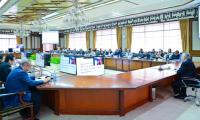The catastrophic impacts of the policies imposed by international monetary institutions were not confined to Africa and Latin America, as discussed in the first part of this article; they also played havoc with the lives of millions in Asia and other parts of the world as well. In Asia, the IMF and the World Bank first encouraged financial liberalization that partly led to the financial crisis in South East Asia during the decade of the 1990s, and they then prescribed a disastrous recipe to address this crisis.
Several experts believe that the crisis was caused in large part by South Korea, Thailand, the Philippines, Malaysia and Indonesia's heavy reliance on short-term foreign loans and openness to hot money. When it became apparent in 1997 that private enterprises would not be able to meet their payment obligations, international currency markets panicked and Asian currencies plummeted. What they forget to mention is the ideology of international monetary institutions that encourage the reliance of countries on short-term foreign loans and openness to hot money which help speculators fulfill their gargantuan appetite for profit and money.
After pushing these countries towards a crisis, the IMF treated the Asian meltdown like other emergency situations, giving assistance only in exchange for structural adjustment policies, which was totally unnecessary because these states were not facing a budgetary deficit issue. Nonetheless, the fund instructed governments to cut spending, which deepened the economic slowdown. In South Korea, for example, a country whose income approached European levels, unemployment skyrocketed from approximately 3 percent to 10 percent. 'IMF suicides' became common among workers who had lost their jobs and dignity.
In Indonesia, the worst-hit country, poverty rates rose from an official level of 11 percent before the crisis to 40-60 percent, and GDP declined by 15 percent in one year. Malaysia stood out as a country that refused IMF assistance and advice. Instead of further opening its economy, Malaysia imposed capital controls, in an effort to eliminate speculative trading in its currency. While the IMF mocked this approach when adopted, the Fund later admitted that it succeeded.
The IMF recipe proved to be very disastrous for the common Indonesian who greatly suffered because of the policies imposed by the global financial body. Prior to the 1997-98 financial crisis, Indonesia had a relatively comfortable debt situation. The government borrowed primarily from the World Bank, Asian Development Bank, and a group of bilateral donors grouped in the Consultative Group on Indonesia (CGI), for funding its development budget. Jakarta approached IMF in 1997 for a $43 billion bailout and within a few years, the bailout turned out to be a great curse for the masses, adding to their miseries and making their lives difficult. In January 2003, the government of the then president Megawati Soekarnoputri raised the prices on fuel (22 percent), telephone (15 percent) and electricity (6 percent). This was happening in a country where inflation was 10 percent in 2002 and more than half of the country's 220 million population lived on less than $2 a day and burdened with more than 40 million unemployed souls.
To tide over the crisis, it was suggested that Indonesia should take specific steps to liberalise trade and investment which included: reducing tariffs on all imported food products to five percent and cutting non-agricultural tariffs to 10 percent by 2003; opening banks to foreign ownership by June 1998; and lifting restrictions on foreign banks by February 1998. Despite taking these drastic measures, the country's financial woes did not decrease. The official debt burden increased from 27 percent of GDP prior to the crisis to more than 100 percent by the end of 1999, before declining gradually. In fact Indonesia, which was ranked as middle-income and middle-indebted before the crisis (at the same level as its neighbours, Thailand and the Philippines), came to be ranked as belonging to the SILIC (severely indebted low income countries) category.
Such reckless policies also contributed to the immiserating of the people in the Philippines where the government kept domestic wages low at the behest of the international financial bodies. This badly affected the marginalized sectors of society, forcing 54 percent of the population to live in absolute poverty while the government debt service was eating up 50 percent of the national budget.
This was the brief history of the disastrous impacts caused by the policies of the global financial institutions. It is difficult to imagine why we still insist on going to such institutions. The policies of international monetary institutions clearly indicate that they seek to benefit the Global North. Their agenda is to facilitate the plundering of third-world countries by the advanced capitalist states. Their mission is not opaque. Their purpose is not mysterious. They are very vocal in making it clear that the Structural Adjustment Programmes are meant to promote the free market. They want developing countries, including Pakistan, to reduce import restrictions, work for the advancement of exports, carry out the privatization of public industries, control wages and leave the social sector at the mercy of market forces.
Which of these points could help the economy? Let us begin with privatization. The mantra of selling state concerns was used to convince people that it would help the country repay loans. We started the process of privatization in the 1980s, which gathered pace after the restoration of democracy in 1988. According to the finance ministry our total debt and external liabilities was $20.90 billion in 1990, rising to $38.86 billion in 2007 and $99.1 billion now. We have sold out more than 160 state-run entities since the 1980s, rendering hundreds and thousands of people jobless. Instead of seeing the country free from debt, what we see today is nothing but a phenomenal surge in our external debt and liabilities which is likely to haunt our coming generations for decades or maybe centuries.
Did these much-vaunted reforms at the behest of international monetary institutions bring any positive change in the lives of millions of Pakistanis? The answer is not difficult to imagine. While the World Bank claims poverty has been reduced, asserting it fell to 29.5 percent in 2014 from 64.3 percent in 2002, Pakistan’s first ever official report on multidimensional poverty, launched by the PML-N government in 2016, says nearly 39 percent of Pakistanis live in multidimensional poverty. The other social development indicators that were meant to be visible after the economic reforms seem to be nowhere either. The country houses more than 25 million out-of-school children. More than 40 percent of children are stunted. Infant mortality rate was 63.3 deaths per thousand live births in 2018. Eighty percent of diseases are caused by contaminated water which is a rare commodity for the majority of the poor, and Hepatitis has become an epidemic in several parts of the country.
Since the arrival of the Tabdeeli Sarkar, inflation has skyrocketed. The prices of petrol and gas have witnessed a phenomenal surge. The champions of employment creation are planning to render tens of thousands workers jobless by privatizing state-run concerns. Given all this, it is more likely that the prescription of the IMF will further add to the miseries. Therefore, it is important that we think of the alternatives. Following the IMF's dictation will do no good. If the advisers of Zardari, Nawaz and Imran are unanimous in seeking help from global financial bodies then the people must realise that they just want to draw to hefty salaries from the public exchequer but want workers' wages to be stagnated. They want to see austerity in the lives of millions of people but would love to stay in five-star hotels and make expensive foreign trips from the taxes of common people. It is time we came up with our own alternative.
Concluded
The writer is a freelance journalist.
Email: egalitarianism444@gmail.com
While these films are fictional, parallels between their narratives and real world discussions about AI are hard to...
Despite their numbers, young voices are often sidelined
Depositors who want to profit from their savings will transfer their money to banks to invest in any business venture
Not surprisingly, our youth see no hope for the future
The post-election situation will be troublesome and worrisome for Modi
Most favourable concept developed so far revolves around public-private partnerships







